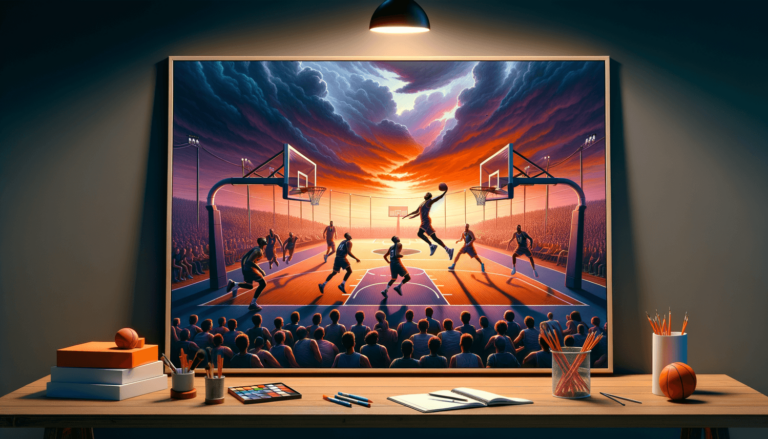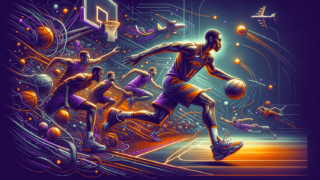
Welcome to another intriguing edition of our basketball blog series! Today, we delve into the mystifying world of the ‘Ghost Screen.’ This phantom maneuver is not as spooky as it may sound, but when executed to perfection, it can bring opponents’ defensive strategies crumbling down like a haunted house. If the idea of mastering this elusive technique gets your adrenaline pumping, then grab a comfy seat and strap in, as we reveal the ins and outs of the ghost screen, uncovering its secrets and showing you how it can be your team’s stealthy ally on the basketball court.
What’s a Ghost Screen in Basketball?
A ghost screen in basketball is a deceptive offensive strategy where a player feints setting a screen for a teammate, only to slip away quickly without making contact with the defender. This play is intended to mislead the defenders, causing them to react to the non-existent screen, creating space and scoring opportunities for the offense.
Unlocking the Magic of the Ghost Screen
The ghost screen is one of the most artful and subtle strategies employed in basketball. It is often used to confuse the defense and create openings for the offensive players to score. To fully understand the magic of the ghost screen, we will first need to break down the essential components that make it so effective.
Athleticism and Basketball IQ: Essential Components for a Successful Ghost Screen
Successfully pulling off a ghost screen in basketball requires that the player possesses two key traits. First, they must be athletic and quick on their feet. In order to sell the illusion of setting a screen, a player needs to have rapid footwork and excellent body control. Second, they must have a high basketball IQ, as timing, awareness of space, and anticipation of the opponent’s movements are critical components of this play.
Preparing for the Ghost Screen
Before setting up a ghost screen, the player must visualize how they will position themselves on the court, both for the initial screen and for the slip away. The best players quickly survey the court, assess their teammates’ positioning, and then make a natural, fluid transition from setting a screen to slipping away. Their movements appear almost instinctive and seemingly effortless.
Setting Up the Ghost Screen
To successfully execute a ghost screen in basketball, careful attention must be paid to the following steps:
1. The Setup
While in possession of the ball, the offensive player must maintain a low stance and communicate with their teammate who will be setting the ghost screen. Proper positioning is key in this initial stage. A slight nod or a hand signal can signal to the screener when to make the fake screen.
2. Selling the Screen
To effectively sell the screen, the player setting the “screen” must initiate their movement toward the defender by sprinting quickly in their direction. The screener should initiate contact with the defender, or at least mimic it, making it appear as though they intend to block or impede the defender’s path. In doing so, the screener tricks the defender into thinking that they are about to be obstructed, causing them to react accordingly.
3. The Slip
Just as the defender is about to encounter what they believe to be a screen, the screener abruptly slips away from the defender’s path. This movement is the core of what makes the ghost screen so tricky to defend. The sudden lack of contact leaves the defender confused as they react to the phantom screen, creating an opportunity for scoring.
Utilizing the Ghost Screen in Different Basketball Scenarios
The ghost screen is a versatile tactic that can be integrated into various offensive plays. Below are several examples of how and when to use the ghost screen.
Pick and Roll Offense
In a pick and roll offense, the player setting the screen pretends to create a barrier for the defender but, instead of making actual contact, slips away quickly, leaving the defender guessing. The ball handler can now take advantage of the confusion created by the ghost screen to either drive to the basket or dish the ball out to a teammate (most likely the player that set the ghost screen) for an open shot or scoring opportunity.
Hand-Off Offense
In hand-off scenarios, the ghost screen can be implemented effectively, as well. As the offensive player hands off the ball to a teammate, they can pretend to set a screen for the new ball handler. However, as the defender reacts to the anticipated screen, the original ball handler can slip away and create space for themselves, opening the opportunity for a quick pass back and an open shot.
Off-Ball Plays
Ghost screens can also be used in off-ball plays, where the screener fakes a screen for a teammate who is cutting or moving off the ball. The player setting the ghost screen will make an initial move, then slip away quickly, leaving the defender disoriented and out of position. This play may lead to open shots or driving lanes for the player who was initially in motion, as their defender has been fooled by the ghost screen.
Defending the Ghost Screen
Defending the ghost screen can be a challenging task, but not an impossible one. The key is to recognize the potential for a ghost screen and react quickly and decisively. Here are some tips to help defenders stifle the ghost screen:
Communication
Proper communication is crucial when defending against the ghost screen. Teammates need to be in constant dialogue, warning each other when a screen, ghost or otherwise, is about to occur. Good communication can help defenders react and switch appropriately, minimizing the threat posed by the ghost screen.
Quick Recognition and Reaction
A keen sense of awareness is vital for a defender to prevent the ghost screen from wreaking havoc. By quickly recognizing the possibility of a ghost screen and reacting accordingly, defenders can stifle the offensive threat before it has a chance to develop.
Maintaining Proper Defensive Position
Another way to defend the ghost screen is ensuring that players maintain proper defensive positioning at all times. By staying low and keeping a strong base, defenders can avoid getting caught out of position, leaving them better prepared to counter the ghost screen.
Learning from the Pros
Many professional basketball players have honed the skill of executing ghost screens with finesse. Studying their play can be a great way for aspiring players to refine their own ghost screen technique.
Steph Curry and Draymond Green
Golden State Warriors’ high-scoring guard Steph Curry and versatile forward Draymond Green have developed a near-perfect ghost screen partnership. Green, well known for his basketball IQ, often sets ghost screens for Curry, who then capitalizes on the distraction to make a key play.
LeBron James and Anthony Davis
LeBron James and Anthony Davis of the Los Angeles Lakers have also incorporated the ghost screen into their formidable offensive arsenal. James, with his superior court vision and Davis’s exceptional athleticism, make it difficult for defenders to predict and prevent ghost screens from occurring.
Mastery Takes Time and Practice
As with many aspects of basketball, perfecting the ghost screen requires an investment in time and practice. By gaining a deeper understanding of the strategy, honing essential skills, and learning from professionals, players can master the art of the ghost screen and unlock new scoring opportunities on the court.
Examples of Ghost Screens in Basketball History
Ghost screens have been a part of basketball for quite some time, leaving their mark on memorable games and legendary matchups. Below are some notable examples of ghost screens in basketball history that demonstrate their effectiveness in real-world situations.
The 2016 NBA Finals – Game 7
The deciding game of the 2016 NBA Finals between the Cleveland Cavaliers and the Golden State Warriors saw a crucial ghost screen set by the Cavaliers’ Kevin Love. In the final minutes of the game, Love faked a screen and slipped away, leaving Warriors’ guard Klay Thompson momentarily baffled. This brief window allowed Kyrie Irving to sink the game-winning three-pointer, ultimately securing the NBA Championship for the Cavaliers.
Regular Season Game – Houston Rockets vs. Oklahoma City Thunder (2018)
In a regular-season game between the Houston Rockets and the Oklahoma City Thunder, Rockets’ guard Chris Paul and forward P.J. Tucker employed the ghost screen to their advantage. As Paul dribbled the ball toward the basket, Tucker set a fake screen, confusing the Thunder defenders and leaving Paul with an open lane to drive and score a layup.
Famous Coaches and Their Take on Ghost Screens
Many prominent basketball coaches recognize the strategic value of ghost screens and have shared their thoughts and perspectives on implementing the technique in their games.
Gregg Popovich – San Antonio Spurs
Legendary NBA coach Gregg Popovich has built a reputation for orchestrating intricate offensive schemes, including the use of ghost screens. His San Antonio Spurs have frequently used this tactic to deceive defenses, creating open shots and driving lanes for their players.
Steve Kerr – Golden State Warriors
Steve Kerr, the head coach of the Golden State Warriors, leverages the ghost screen in his offensive playbook to capitalize on the high basketball IQ of players like Draymond Green and Steph Curry. This tactical move has played an integral role in the team’s multiple NBA Championship victories.
Teaching Ghost Screens to Youth Players
Although the ghost screen might be considered an advanced offensive strategy, it can still prove invaluable to teach young basketball players. Introducing this technique to future stars will not only add an intriguing component to their game but also allow them to develop their understanding of offensive principles and enhance their overall skillset.
Building a Solid Foundation
Before teaching youth players about the ghost screen, they must first develop a solid foundation in fundamentals, such as passing, shooting, and dribbling. Ensuring that they possess these critical basketball skills will enable youth players to better execute and appreciate the ghost screen.
Creating a Positive Environment
When introducing ghost screens to youth players, it is crucial to create a positive and supportive environment that fosters learning and growth. Encourage them to ask questions, express concerns, and most importantly, learn from mistakes. Emphasizing the importance of communication and teamwork will go a long way in helping young athletes grasp the concept and execute it effectively on the court.
Continuing the Ghost Screen Journey
By now, you should possess a deeper understanding of the ghost screen and its role in the game of basketball. Whether you are a player seeking to improve your offensive skills, a coach looking to expand your playbook, or a casual fan engaged in the sport’s strategic elements, you can appreciate the unique and elusive charm of the ghost screen – a potent weapon in competitive basketball.
Frequently Asked Questions
Are you intrigued by ghost screens in basketball and seeking to learn more? Below, we address some common questions that may arise as you navigate the realm of ghost screens. Discover valuable insights and practical tips in this handy FAQ guide.
1. How do I know when to use a ghost screen in a game?
Knowing when to use a ghost screen primarily depends on the specific offensive play and the positioning of the defenders. Good communication with your teammates and a strong understanding of court dynamics are essential factors in determining the right moment to execute a ghost screen.
2. What makes a ghost screen effective?
The effectiveness of a ghost screen hinges on its ability to deceive the defense. A proper setup, convincing feint, and seamless slip are all key components that contribute to the success of the ghost screen in creating open shots and scoring opportunities.
3. Can ghost screens be used in any offensive system?
While ghost screens may not be suitable for every offensive system, they are highly adaptable and can be integrated into many different schemes, including pick-and-roll plays, hand-off offenses, and off-ball movements.
4. How do I effectively communicate with my teammates to set up a ghost screen?
Players can use various non-verbal cues, such as hand signals, eye contact, or head nods, to communicate their intention to set a ghost screen. Verbal communication, including calling out plays or using code words, can also aid in effective communication during a game.
5. Who are some famous players who excel at setting ghost screens?
Notable players who have a reputation for setting effective ghost screens include Draymond Green, Kevin Love, and Anthony Davis. Their skills and basketball IQ, paired with their athletic abilities, make them exceptional at executing this elusive strategy.
6. How do I practice ghost screens during training?
Practicing ghost screens during training requires a focus on timing, positioning, and footwork. Drills that simulate game scenarios are ideal for honing this technique. Additionally, watching film of professional players and observing their usage of ghost screens can further aid in practice.
7. What other offensive strategies can be paired with ghost screens?
Ghost screens can be combined with various offensive strategies such as pick-and-pop plays, backdoor cuts, and off-ball screens to create confusion among defenders and open up scoring opportunities for the offensive team.
8. How can I improve my footwork for ghost screens?
Improving footwork for ghost screens involves refining movement mechanics through practice and repetition. Agility drills, ladder exercises, and specific techniques like the Euro step can help players develop quick, nimble footwork required for setting convincing ghost screens.
9. Are ghost screens considered illegal in basketball?
Ghost screens are entirely legal in basketball, as they involve no illicit contact with opposing players. The primary purpose of this strategy is to deceive defenders rather than impede their movement through physical contact.
10. How can I defend against ghost screens?
Defending against ghost screens requires strong communication, quick recognition of the tactic, and maintaining proper defensive position. By working together as a team and keeping an eye on the court dynamics, defenders can counter the threat posed by ghost screens.
11. At what age should young players start learning about ghost screens?
It’s generally best to introduce ghost screens to young players once they have a solid grasp of fundamental basketball skills, such as passing, shooting, and dribbling. Mastery of these essentials will facilitate a smoother transition to learning more advanced tactics like the ghost screen.
12. Can a guard set a ghost screen for a big man?
While ghost screens are typically set by big men for their guard teammates, they can also be employed the other way around. The key is for the guard to effectively sell the screen and slip away, creating confusion among the defenders and an opportunity for the big man.
13. How do coaches teach players about ghost screens?
Coaches can impart knowledge of ghost screens through various methods like film study, offensive play breakdowns, and team drills. The most effective approach is to ensure players understand the strategic value of the move and the mechanics involved in executing it seamlessly.
Featured Posts
- No pillar pages found.





